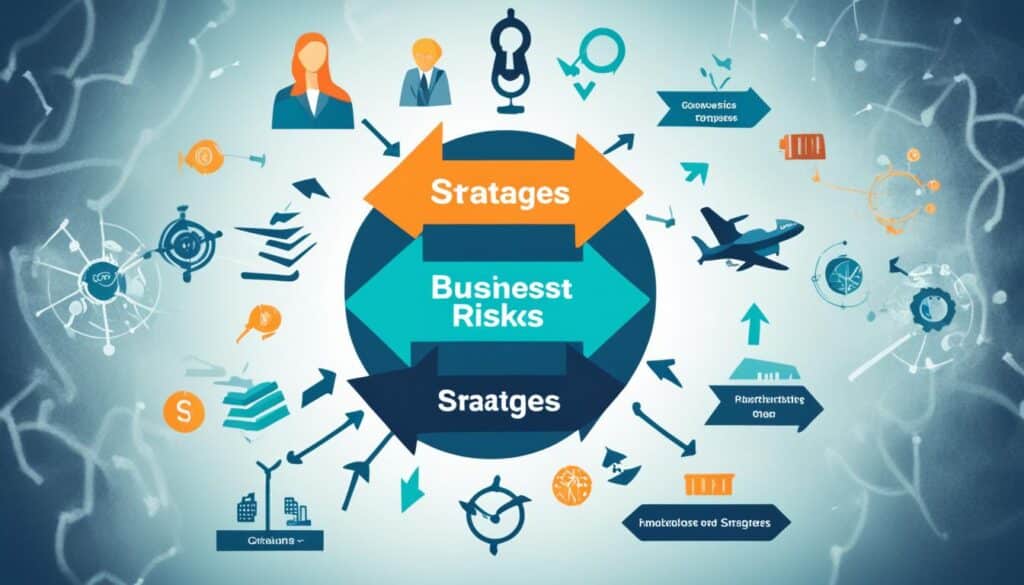Businesses today face many challenges from various sources. These can include economic shifts, new technologies, environmental issues, and strong competition. To overcome these obstacles, companies need strong risk management strategies. Companies using good risk management are more likely to gain the trust of their stakeholders and see better business results. They are also set up for faster revenue growth.
Risk management frameworks are vital for businesses. They help to spot, evaluate, and deal with possible risks. This allows companies to keep running, protect the interests of everyone involved, and prepare for growth. By dealing with risks early, businesses can avoid big problems, use new chances, and make their position in the market stronger.
Key Takeaways
- Effective risk management strategies are essential for businesses to navigate complex and dynamic environments.
- Companies that embrace strategic risk management are more likely to deliver stakeholder confidence and better business outcomes.
- Implementing a comprehensive risk management framework helps businesses identify, assess, and mitigate potential risks.
- Proactive risk management enables businesses to minimize disruptions, leverage emerging opportunities, and strengthen their competitive advantage.
- Effective risk management strategies are crucial for ensuring long-term business sustainability and growth.
Introduction to Risk Management
Risk management is vital for any business. It’s about spotting, understanding, and fighting off threats. By doing this, organizations can aim for success without stumbling over the many risks they face.
What is Risk Management?
Harvard’s Robert Simons tells us that growing, culture, and information management bring risks. These risks can hurt a company through operations, assets, competition, or their brand. So, businesses need to be smart about how they handle these dangers.
So, what exactly is risk management? It’s a method. It looks at the odds and damage risks might cause. Then, it comes up with ways to keep this harm as low as possible. And it keeps an eye on whether these plans are working. This lets companies tackle problems inside and outside their walls.
“Risk management is not just about avoiding or minimizing risk; it’s about understanding and owning risk to create value and achieve organizational objectives.”
Good risk management is like having a superpower. It helps organizations make smart choices and spend their resources wisely. This makes them tougher against anything that comes their way. With good risk strategies, businesses can even turn dangers into chances. This improves their place in the market and helps them last a long time.
The Importance of Risk Management for Businesses
In today’s world, risk management is vital for protecting a company’s image and reducing financial harm. It also helps in fostering new ideas and making better choices. By spotting and dealing with potential problems early, businesses can cut down on damage that might hurt them.
Keeping a good name is crucial for any business. With the right risk management, a company can deal with troubles well. This keeps them trustworthy to their customers and partners. Good risk management stops problems from hurting a company’s brand.
Also, it helps companies keep their money safe. Knowing and fixing risks early, like changes in the market, means less loss or cost later. This lets businesses use their money better, invest in growth, and be more profitable.
Risk management isn’t just about keeping a company safe. It also encourages them to try new things and grow. A good plan lets a business take smart risks to find new chances, like new products. This makes the business more competitive and successful in the long run.
Lastly, risk management improves how companies make choices. It gives leaders a clear look at dangers and their effects. This helps them make smarter, more confident decisions. Good decisions lead to better use of resources, solving problems well, and facing the future with strength.
The Importance of Risk Management in Action
Here’s an example to show how important risk management is. A big tech company had a data breach, putting millions of customer records at risk. Because of their strong risk management plan, they could act quickly. They talked openly with everyone and made their systems more secure. This not only limited the harm to their money and reputation but also showed they’re trustworthy and responsible.
“Effective risk management is not about eliminating risk, but about managing it in a way that supports the organization’s objectives.” – John Doe, Risk Management Consultant
To sum up, risk management is key for a company’s success and lasting power. It shields their good name, saves them money, helps them grow, and makes their choices better. It’s a must for any company aiming for long-term success.
Types of Strategic Risks

Businesses face many strategic risks. These include operational risk, asset impairment risk, competitive risk, and franchise risk. Knowing them well is vital for business success.
Common Strategic Risks for Businesses
Operational Risk: This risk comes from within. Mistakes in operations can stop the business from working smoothly. This includes errors when shipping goods or system failures.
Asset Impairment Risk: When a business’s assets lose a lot of value, it’s asset impairment risk. A major cause can be losing a key manufacturing plant in a natural disaster.
Competitive Risk: Changes in the competitive market can hurt a business. They can make it harder for the company to stand out and keep losing market share.
Franchise Risk: This happens when others lose faith in a business’s goals. It often comes from not handling other strategic risks well.
“Effective risk management strategies are essential for businesses to navigate the ever-changing competitive landscape and protect their long-term viability.”
Knowing these risks helps organizations plan better. They can focus on managing risks and spotting new chances. This can help keep the business strong in the long run.
Reasons Why Risk Management is Crucial
Effective risk management is key for good business. It’s vital for every organization’s success, no matter their size or field.
Protecting Reputation
Risk management is first on the scene to defend a company’s image. It tackles possible troubles early on, which could otherwise harm how people see the business. This way, companies keep their good name and the trust of clients, partners, and the public.
Minimizing Financial Losses
One big plus of risk management is cutting financial risks. This includes putting policies in place to manage things like employee issues or sudden market changes. Companies with strong risk management can keep growing and innovating without the fear of major setbacks.
Encouraging Innovation and Growth
Surprisingly, risk management also boosts invention and expansion. It helps firms deal with uncertainties in a structured way. By doing so, they become more ready to explore new options and stay sharp in the market.
Enhancing Decision-Making
Risk management makes for smarter decisions too. It uses data and a broad approach to spot and handle risks. This way, leaders make more solid choices that lower dangers and open up new chances, leading to better business results.
In summary, risk management is essential for success in any business plan. It guards the company’s image, cuts financial risks, and spurs on growth and sound decision-making. Companies that are alert about risk management are better set to handle the challenges of the modern market, and to stand strong over time.
Risk Management Strategies
When dealing with risks in the business world, different strategies can be used. These aim to deal with and lessen the many risks companies might face. The five main risk management strategies are: risk acceptance, risk transference, risk avoidance, risk reduction and loss prevention, and risk sharing.
Risk Acceptance
Risk acceptance means knowing the risks in a situation and choosing not to act to lessen them. This can be a choice when a risk’s impact is small or it costs too much to lower the risk. By accepting the risk, a company takes full responsibility for any bad outcomes.
Risk Transference
Risk transference moves the duty of risk management to someone else, like through contracts or insurance. It’s helpful for risks outside a business’s control or too expensive to manage. This way, the organization shields itself from possible loss.
Risk Avoidance
Risk avoidance is about taking steps to stop a risk from happening. This can mean steering clear of certain activities, goods, or markets. Or, it could involve putting in strong controls to lower the risk of it occuring. Although effective, it might hold back growth and chances.
Risk Reduction and Loss Prevention
Risk reduction and loss prevention focus on lowering the impact of risks that can’t be avoided. This could include backup plans, spreading business areas, or new tech to mitigate risks. By doing this, companies protect themselves and those involved.
Risk Sharing
Risk sharing spreads the duty of risk management to several groups, like through partnerships or joint projects. It’s good for big or complex risks. It helps in dividing the task of handling the risk among partners or within an organization.
By knowing and using these risk management strategies, businesses can move through their unpredictable surroundings better. This ensures they remain successful and sustainable in the long run.
“The art of risk management lies not in eliminating the risk, but in striking the right balance between the potential rewards and the potential consequences.” – Anonymous
The Risk Management Process

Risk management is key for any business to succeed. It involves four main steps: identifying risks, analyzing them, controlling, and financing. This method helps organizations spot, understand, and reduce threats. This makes them stronger and able to last longer.
Risk Identification
The first step looks at what could harm the business. It means studying things inside and outside the company that could be a risk. Market changes, new laws, or new tech are examples. Knowing these risks helps businesses get ready to face them.
Risk Analysis
The next step is to deeply understand each risk. This means looking at how likely a risk is and what damage it could do. Knowing these details lets a business focus on the most important risks first. It also helps them use their resources wisely.
Risk Control
After understanding the risks, the focus shifts to controlling them. This part can include many actions. From making plans to reduce risks, to having backup plans, or using insurance. By being proactive, businesses can lower their risks a lot.
Risk Financing
The final step is deciding how to pay for risks. This can be done through insurance, saving money for future costs, or other methods. Having enough financial backup helps businesses bounce back after a risk hits.
Timely and smart claims management is also very important. This is about handling any claims from risk events quickly. It’s important for keeping the business’s money and reputation safe.
“Successful risk management is not about eliminating risk, but about making informed decisions to manage it effectively.” – Anonymous
By using this risk management process, a business can get better at dealing with risks. They become more resilient and stand out in the market.
Risk Management Examples
Risk management helps companies handle dangers that can come in different forms. These risks can be safety issues or following laws. They also include keeping data secure. Companies need good plans to deal with and lower these risks. Let’s look at how different businesses manage risks in their own ways.
Compliance Risks
It’s very important for companies to follow the rules set by their industry and the law. They have to keep an eye on these rules and make sure their ways of working are correct. This process can involve a lot of checking and fixing to stay in line with what’s required.
Safety Risks
Keeping employees safe at work is crucial. Companies do this by setting up safety measures and training. They should find any risks around the workplace and then put safety steps in place. This way, they build a culture where safety is top priority.
Information Security Risks
With so much business happening online these days, protecting data is key. Companies use Risk management strategies for information security to stay safe. They work on having strong online defenses and keeping an eye on their systems. This careful approach can help them avoid being hacked or losing important data.
| Risk Type | Example | Risk Management Strategies |
|---|---|---|
| Compliance Risks | Regulatory changes in the financial industry | Continuous monitoring of regulatory updates, internal audits, and implementation of corrective actions |
| Safety Risks | Potential hazards in a manufacturing facility | Risk assessments, implementation of safety controls, and employee training programs |
| Information Security Risks | Cyberattacks and data breaches | Enhancing cybersecurity measures, implementing access controls, and regular security system testing |
These cases show how different risks need specific plans to tackle them. By being prepared and dealing with various risks, companies can become stronger. They protect what’s important and keep their future safe.
“Effective risk management is not about eliminating risk, but about managing it in a way that supports the achievement of an organization’s objectives.”
Risk Management Tools

Risk management is essential for businesses to handle unknowns and reach their goals. Companies use several tools like SWOT analysis, root cause analysis, and brainstorming. These help to spot, understand, and deal with risks.
SWOT analysis lets businesses look at their strengths, weaknesses, opportunities, and threats. It gives them a deep view of their environment and helps plan ahead. This way, they can take on challenges before they become big problems.
Root cause analysis focuses on finding the main reasons behind issues. It’s not just about fixing what seems wrong at first glance. It’s about stopping problems from happening again by going straight to their causes.
- Risk registers keep a record of all the possible risks in one place. They help manage and watch over risks as projects or companies move forward. This makes it easier to catch and deal with risks early.
- Probability and impact matrices help figure out which risks are most important to address. They focus on what’s likely to happen and could cause the most harm. This way, businesses can concentrate on the risks that matter the most.
- Brainstorming sessions gather different experts to come up with new ideas to fight risks. These meetings are a chance to find fresh, creative solutions to tough problems. They can bring out the best in a team’s thinking.
| Risk Management Tool | Description | Key Benefits |
|---|---|---|
| SWOT Analysis | Examines a company’s Strengths, Weaknesses, Opportunities, and Threats | Provides a comprehensive understanding of internal and external factors that impact the business |
| Root Cause Analysis | Identifies the underlying causes of problems or risks | Enables the development of effective solutions that address the root of the issue |
| Risk Register | Centralized repository for cataloging and tracking potential risks | Ensures timely identification and mitigation of risks |
| Probability and Impact Matrix | Prioritizes risks based on their likelihood and potential impact | Helps organizations focus on the most critical risks |
| Brainstorming | Collaborative sessions to generate creative solutions and insights | Uncovers innovative approaches to risk management |
These tools help businesses stay ahead by spotting and solving risks early. They make smart decisions and keep their edge in the market.
“Effective risk management is not about eliminating risk, but about managing it in a way that supports the achievement of an organization’s objectives.”
Building a Comprehensive Risk Management Strategy

To thrive, businesses need a strong risk management plan. This plan helps them face current and future challenges. It all starts with a risk assessment. This helps spot what could go wrong and how likely it is.
After finding the risks, companies can use specific risk mitigation strategies. They might try to avoid the risk, pass it on to someone else, or lessen its impact. The key is to keep looking at and adjusting your plan. You must always be ready for new risks.
Getting everyone in the company to understand and deal with risks is also key. This is done through good employee training. Everyone in every team needs to know how they can help keep the company safe from risks.
By facing risks head-on, businesses can stay strong and safe. They’re then more likely to succeed, even when things are uncertain.
“The only way to make sense out of change is to plunge into it, move with it, and join the dance.”
– Alan Watts, philosopher
Implementing Risk Management Strategies
Effectively using risk management strategies needs several steps. Companies might test solutions in small projects before using them widely. With buffers like extra money or resources, they can limit the harm from sudden problems.
Deciding if a risk is worth taking means looking at the possible rewards. Contingency planning is making backup plans for different risk situations. Also, looking at what went wrong in the past and teaching staff about risks is key.
- Conduct business experiments or pilot projects to test risk mitigation solutions
- Build buffers to contain the impact of unexpected events
- Perform risk-reward analysis to determine the viability of potential strategies
- Implement contingency planning to prepare for various risk scenarios
- Learn from past risk incidents and conduct data analysis to identify vulnerabilities
- Educate employees on risk awareness and mitigation techniques
“The greatest risk of all is not taking one.” – Mark Zuckerberg
| Risk Management Strategy | Description | Key Benefit |
|---|---|---|
| Business Experiments | Pilot projects to test risk mitigation solutions | Identify effective strategies before full implementation |
| Buffers | Financial or resource safeguards | Contain the impact of unexpected events |
| Risk-Reward Analysis | Evaluate potential benefits against risks | Determine the viability of risk management strategies |
| Contingency Planning | Prepare alternative solutions for risk scenarios | Ensure business continuity in the face of disruptions |
With a full strategy for risk management, companies can deal with the twists of today’s market.
Also Read: Understanding Long-Term Care Insurance Benefits
Conclusion
Effective risk management is a must for businesses big and small, across all industries. With the right strategies, companies can safeguard their name, cut down on money loss, encourage new ideas, and grow. Also, they can make better choices by spotting, assessing, and handling possible dangers. This keeps the business running and looks after those involved.
Risk management isn’t only about solving problems after they show up. It’s about readying yourself to face unknowns and still do well. Focusing on risk management helps firms be tougher, more competitive, and ready for the future. It’s vital in today’s fast-paced world.
Overall, understanding risks is key to running a successful business. It lets companies act wisely, avoid dangers, and grab chances when they come. With a strong risk management plan, businesses do better, keep everyone safe, and stay around for the long haul. It’s all about being smart and proactive in the changing business world.
FAQs
Why do businesses need risk management strategies?
Risks are everywhere for companies, from tech changes and economic shifts to challenges from the environment and competitors. Having strong risk management helps businesses see, understand, and deal with risks. This keeps the business going and looks out for those who are part of it.
What is risk management?
Risk management is a way to discover, review, and handle the threats an organization faces. It means thinking about how likely a risk is and what its impact could be. Then, it’s about making plans to lessen the damage and checking if these plans work.
Why is risk management crucial for businesses?
For companies, good risk management is key. It protects their image, lessens money losses, and fuels progress. It helps them make smart choices and reduce harm from risks before they strike. This way, companies chart a safer course for their future.
What are the common types of strategic risks for businesses?
Strategic risks come in many forms. There’s operations risk, like when things go wrong inside a company that stop its products or services. Asset impairment risk is when a company’s assets lose a lot of value. Competitive risk and franchise risk are other big ones, hitting companies when they face more rivals or lose support.
What are the key benefits of risk management strategies?
Managing risks well brings major benefits. It safeguards a company’s good name and its finances. It also spurs innovation, helps with big choices, and let companies adjust faster to new competitions. Essentially, it’s about turning possible risks into opportunities while keeping the bad outcomes at bay.
What are the different types of risk management strategies?
There are five main risk management strategies. These include: accepting the risk, moving it to someone else, dodging the risk, lowering the risk’s impact, and sharing the risk with others. Each strategy offers a different way to deal with possible hazards.
What are the steps in the risk management process?
Managing risks follows four main steps. First is identifying what can go wrong. Then, it’s about figuring out how bad these risks could be. Next, companies put measures in place to control or avoid the risks. Last is making sure there’s enough money or resources to handle any problems if they happen.
Can you provide some examples of risk management in businesses?
Risk management can handle many kinds of threats. One is keeping up with laws to avoid penalties, which is a compliance risk. Another is ensuring workplaces are safe to stop accidents, a safety risk. Yet another is preventing data breaches by tightening up digital defenses, an area called internet security. Companies use various plans and tools to keep these threats in check.
What are some risk management tools that businesses can utilize?
There’s a toolkit for managing risks that includes things like SWOT analyses and looking into the roots of problems. Other tools include lists of risks, ways to rate them by severity, and creative meetings to brainstorm solutions. These methods help companies look carefully at their hazards and take actions to protect themselves.
What are the key steps in developing a comprehensive risk management strategy?
To create a strong risk management plan, start by checking all possible dangers. Then, set up ways to deal with these risks. Keep an eye on how things go, and always be ready to adjust the plan. Making sure everyone in the company knows the plan and is trained in their role is also critical.
How can businesses effectively implement risk management strategies?
Put in a lot of thought and work to make risk management work. Test out ideas first, keep some resources ready, and think deeply about the payouts and risks of different choices. Learn from mistakes, gather as much info as possible, and train everyone to see and fix risks effectively. With these steps, a business can stay ahead of potential problems.
Source Links
- https://online.hbs.edu/blog/post/risk-management
- https://www.marshmma.com/us/insights/details/risk-management-strategies.html
- https://safetyculture.com/topics/risk-management/